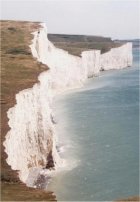
May Editorial

May Editorial
Seven Sisters |
|
This is the second of our editorials focusing on geologically interesting places with unusual rock formations. In the April editorial we talked about Meteora in Greece. This month we travel to the coast of southern Britain, to the Seven Sisters, located within the Country Park, approximately 14 miles East of Brighton, where the Sussex chalk cliff meets the sea. The Seven Sisters coastline is composed largely of chalk, and boasts the most extensive and least disturbed stretch of chalk shore anywhere in the country. The geological structure of this southern coastline is particularly unusual since chalk is otherwise rare in Britain. Although chalk is abundant at the Seven sisters, the main building block of the coastline is flint – a black hard rock with an outer whitish crust, composed of crystals and silica. A major problem of the chalk coastline is extensive erosion The cliffs are receding 30-40 cm each year on average. Being a very soft rock, chalk is easily washed away by the sea, uncovering the flint which breaks off and accumulates further down the coast as shingle (beach gravel consisting of large smooth pebbles unmixed with finer material) on the beaches. On the beaches wave action batters the individual flints together and they become rounded (but rarely spherical) pebbles. Because waves generally approach this coast from a southwesterly direction, the shingle tends to drift along the beach from west to east. Apart from flint and chalk the Seven sisters area is also famous for its fossils. These include a variety of brachiopods, bivalves and echinoids. The best place to look for fossils is within the shingle and chalk on the foreshore.
And finally, treasure hunters should look for the heavy rust-looking spherical or sausage-shaped lumps which can be occasionally found on the beach. This are not thunderbolts or meteorites, but iron sulphide mineral pyrite or marcasite. If broken they reveal a mass of radiating golden crystals within. Sadly these rapidly oxidise and tarnish - fools' gold!
 Fool's Gold Fool's Gold
|
| _______________________________ | ||||
| Home | | | Shopping | | | Database |
© Biscuit Software 2004-2015
All rights reserved